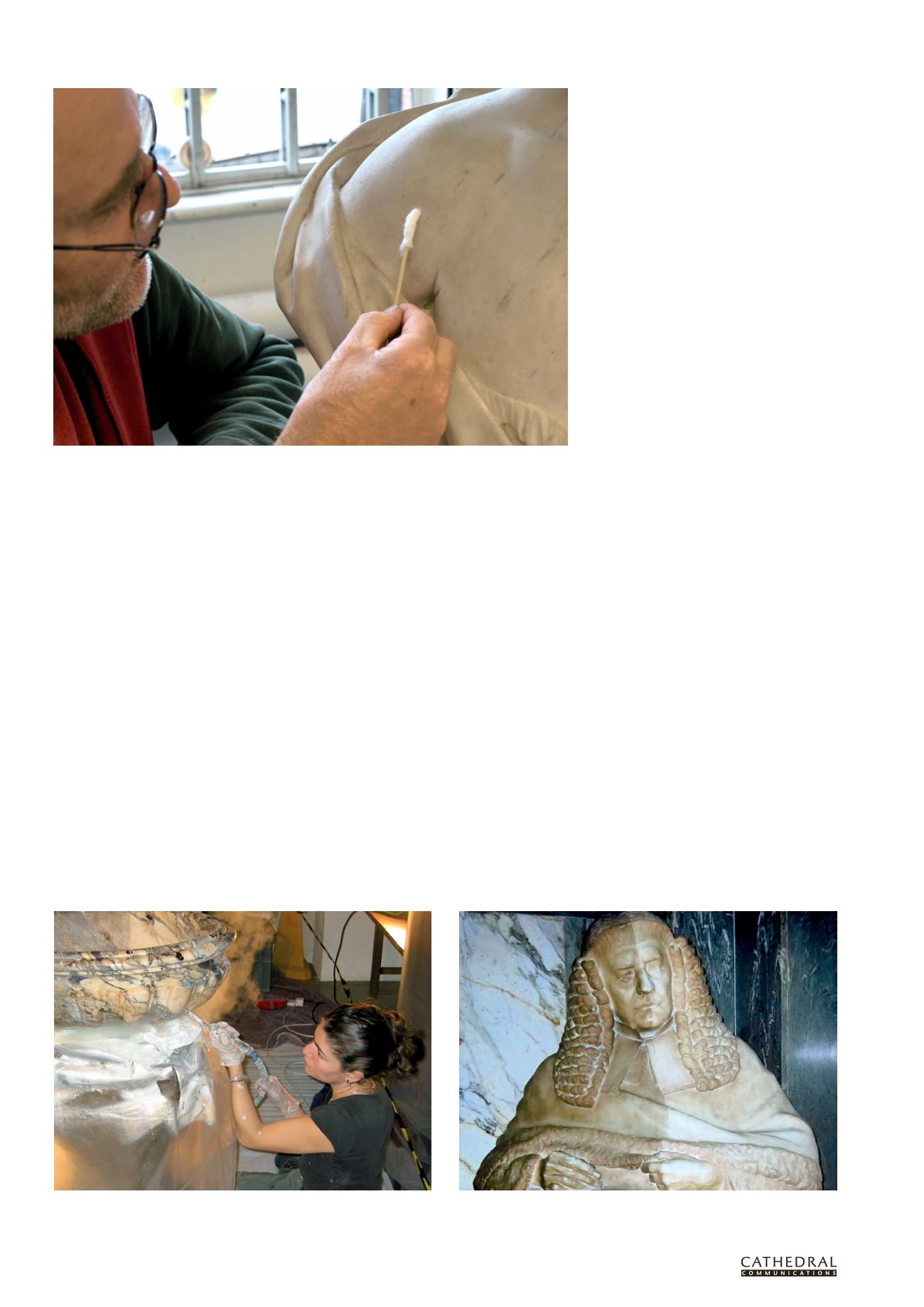
1 3 8
T H E B U I L D I N G C O N S E R VAT I O N D I R E C T O R Y 2 0 1 4
T W E N T Y F I R S T E D I T I O N
SERVICES & TREATMENT :
PROTEC TION & REMEDIAL TREATMENT
4.1
A close examination of the surface
should help to identify the material, assess
its condition in terms of structure and
surface, understand that condition and,
if possible, determine what has caused it.
Any surface finishes such as the remains of
painted decoration or gilding should also be
located and identified. Decorative finishes
on marble monuments tend to be restricted
to inscriptions, heraldic devices and other
minor decorative elements (for example,
column fluting and capitals being picked out
in gilding).3
Analysis of a painted finish through cross-
section examination or identification of paint/
pigment types can be used to distinguish
original decoration, which should always be
retained, from later interventions that may be
removed if appropriate. A close examination
of a monument’s surface should also reveal
any structural defects such as hairline
cracking or joint movement which may need
to be addressed before cleaning.
Following close examination, careful
and objective tests should be specified
and undertaken before continuing with a
programme of cleaning. Experience of similar
projects will inform the conservator in what
materials and methods should be trialled,
but it is always sensible to start with the most
benign procedures.
The key is to develop the tests, preferably
in groups that are similar in nature (such
as various mineral solvents), and to give
them the time to work properly. That
also means, for example, allowing time
for a trial area of marble to dry out fully
so that the stable cleaned surface can
be judged. A wet surface can often give
a false idea of the final appearance.
THE CLEANING PROCESS
The decision to proceed with cleaning may
be left to the conservator alone, but more
often than not a range of people take part in
the process. This often involves managing
people’s expectations. Trials to select the
most appropriate cleaning method and to
establish the degree of cleaning that can
be achieved without risk are essential, and
the conservator should present a clear and
concise explanation and assessment of the
trials to the client and others responsible
for decision-making. It is important that the
process and materials being recommended
are fully understood by all concerned,
rather than just the visual result.
At the most basic level, a light dusting
with a fine, soft cloth (an ‘e-cloth’ for example)
or a fine, soft-bristle brush can remove a
dulling layer of dust and grime. A brush
should be used with a vacuum cleaner with
the edges of the nozzle covered with padding
(such as ethafoam). If there is any danger of
loose sections dislodging, a layer of gauze can
be placed over the end of the nozzle to prevent
any original material being sucked up.
Mechanical cleaning may include
careful removal of poorly executed fills
and repairs which are obscuring areas of
original surface. Extreme care should be
taken using hand tools such as scalpels and
fine chisels, and abrasion of the marble
surface should be avoided at all costs.
Wet cleaning is likely to involve a range
of detergents and/or solvents. These may be
used singly or in combination. For example,
a standard non-commercial formula (known
to conservators as ‘Kill quick’ or the ‘V&A
mix’) combines water and white spirit with
a small amount of non-ionic detergent.
This is applied by swab or brush and can be
lightly agitated with a bristle brush before
removal and careful rinsing with clean water.
Wet cleaning techniques act by dissolving
or mobilising deposits so it is important
that these are lifted from the cleaned
surface using cotton wool or absorbent
paper to prevent re-soiling of the marble.
Steam cleaning can be carried out
using small portable dental cleaners which
have been successfully employed both in
conservation studios and on site. These allow
very controlled targeted cleaning to be carried
out at a pressure of c3–5 bar (40–75 psi).
A new generation of larger steam
cleaners which superheat the water have been
developed for use in building conservation.
These are controllable enough for use in
cleaning external marble monuments where,
for example, removal of biological growth
or rinsing after poulticing of sulphation*
is carried out. Again, the marble should be
carefully examined first and only sound
surfaces should be cleaned by this method.
However, these machines should not be
Using a portable steam cleaner to clean a decorative marble font
Marble figure during steam cleaning
Solvent swabbing a lightly soiled marble surface


